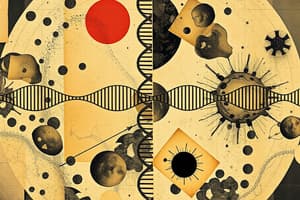Podcast
Questions and Answers
What is Interphase?
What is Interphase?
- Working stage of the cell; G1, S, G2 (correct)
- Stage where chromosomes condense
- Stage where cell divides
- None of the above
What occurs during Prophase I?
What occurs during Prophase I?
The pairing of homologous chromosomes to form tetrads, crossing over occurs, nuclear envelope breaks down, spindle fibers form.
What happens in Metaphase I?
What happens in Metaphase I?
Homologous pairs of chromosomes or tetrads line up along the middle of the cell.
What is the main event during Anaphase I?
What is the main event during Anaphase I?
What occurs in Telophase I?
What occurs in Telophase I?
What takes place during Prophase II?
What takes place during Prophase II?
Describe what happens in Metaphase II.
Describe what happens in Metaphase II.
What occurs during Anaphase II?
What occurs during Anaphase II?
What is the outcome of Telophase II?
What is the outcome of Telophase II?
What happens in the 1st Cell Division?
What happens in the 1st Cell Division?
Flashcards are hidden until you start studying
Study Notes
Meiosis Overview
- Meiosis is a two-stage process of cell division that results in four haploid daughter cells from one diploid parent cell.
- Key stages include Meiosis I and Meiosis II, each with distinct phases.
Interphase
- Working stage of the cell, consisting of three phases: G1, S, and G2.
- During interphase, the cell prepares for division, grows, and duplicates its DNA.
Prophase I
- Homologous chromosomes pair up to form tetrads, allowing genetic recombination through crossing over.
- The nuclear envelope disintegrates, and spindle fibers begin to form.
Metaphase I
- Tetrads align along the equatorial plane of the cell, facilitating the random assortment of chromosomes.
Anaphase I
- Spindle fibers pull homologous chromosome pairs (tetrads) to opposite poles.
- Sister chromatids remain attached at their centromeres throughout this phase.
Telophase I
- Each pole of the cell has a haploid set of chromosomes, each still composed of two sister chromatids.
- Cytokinesis occurs, resulting in the formation of two haploid daughter cells.
Prophase II
- Chromatin condenses back into visible chromosomes, and spindle fibers develop without homologous pairing.
- This stage prepares the cells for the second meiotic division.
Metaphase II
- Duplicated chromosomes line up individually along the cell's equator, allowing for separation of sister chromatids.
Anaphase II
- The spindle fibers attach to the centromeres of duplicated chromosomes, pulling the sister chromatids apart toward opposite poles.
Telophase II
- Homologous chromosome pairs reach opposite poles, and a cleavage furrow begins to form.
- Results in a total of four haploid daughter cells, each genetically distinct from the parent cell.
1st Cell Division
- The first meiotic division results in two haploid daughter cells, each entering the second meiotic division for further genetic variation.
Studying That Suits You
Use AI to generate personalized quizzes and flashcards to suit your learning preferences.




